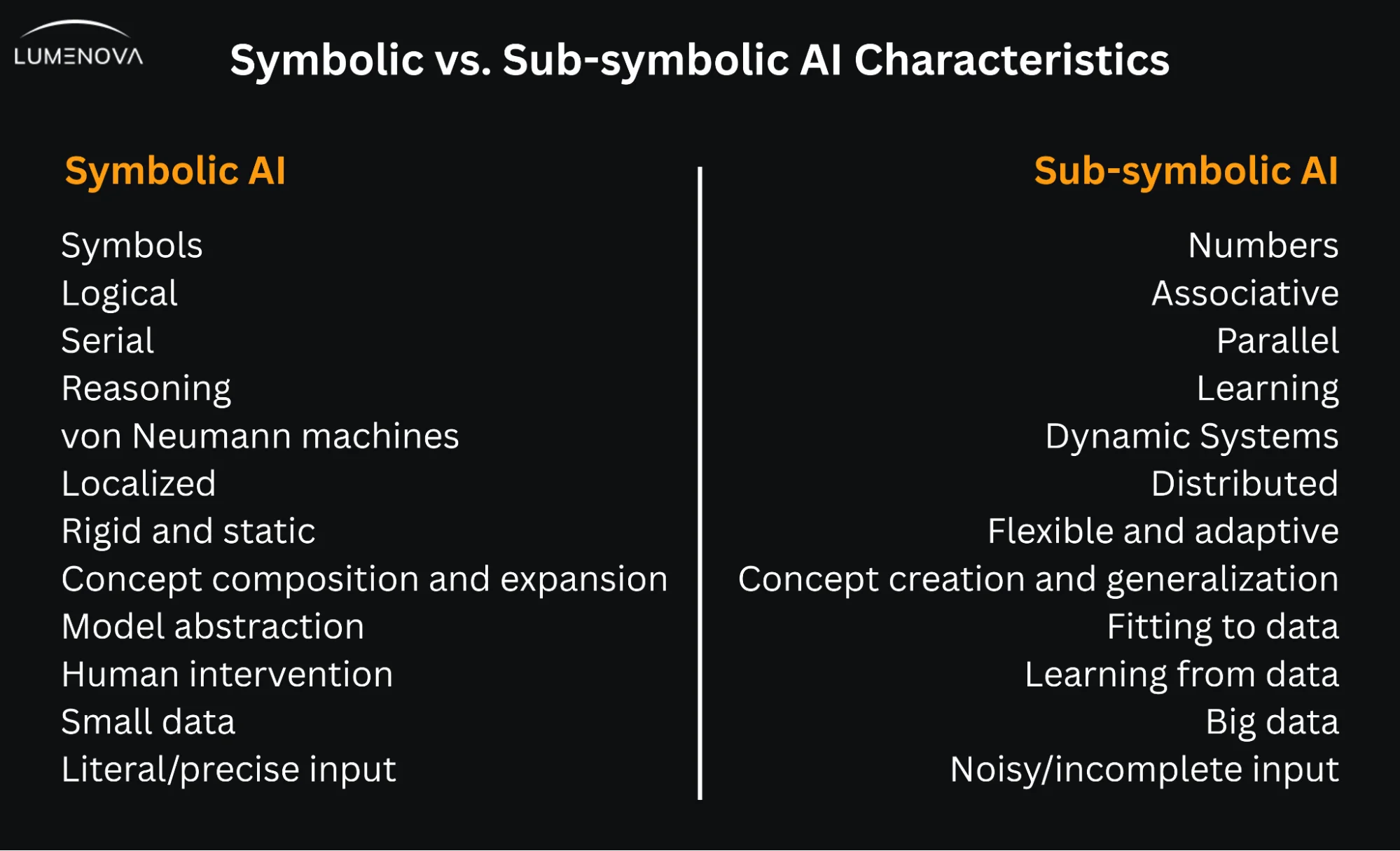Symbolic AI
Symbolic AI represents knowledge using symbols and applies logical rules to process information. This approach enables machines to perform reasoning tasks. It has played a foundational role in AI research, powering early expert systems, knowledge representation models, and logic-based reasoning tools.
How Symbolic AI Works
It relies on structured logic and predefined rules to interpret data. Key components include:
- Symbol Representation: Concepts are encoded as symbols with defined relationships.
- Rule-Based Reasoning: Logical operations manipulate symbols to infer conclusions.
- Knowledge Graphs and Ontologies: Data is structured hierarchically to facilitate decision-making.
- Formal Logic Systems: Predicate logic and first-order logic guide AI reasoning.
Symbolic vs. Subsymbolic AI
AI development has led to two primary approaches:

- Symbolic AI: Operates using explicitly programmed rules and symbolic relationships.
- Subsymbolic AI: Uses statistical models, such as neural networks, to learn patterns from data.
- Hybrid Models: Neuro-symbolic AI combines both techniques, enhancing reasoning capabilities with data-driven learning.
Applications of Symbolic AI
It is typically used in:
- Expert Systems: Early AI programs that provided domain-specific decision support.
- Natural Language Processing (NLP): Rule-based methods for syntactic analysis and language understanding.
- Business Intelligence: Knowledge graphs structure enterprise data for more effective retrieval and decision-making.
- AI Ethics and Explainability: Symbolic AI improves transparency by allowing human-readable reasoning steps.
Neuro-Symbolic AI: Bridging Logic and Learning
The integration of neural-symbolic AI seeks to enhance modern AI by combining logical reasoning with deep learning. This approach improves AI’s ability to:
- Explain decisions with structured reasoning rather than opaque model outputs.
- Reduce bias by encoding ethical rules into AI behavior.
- Generalize across domains by integrating logical inference with learned representations.
Future of Symbolic AI
Despite the rise of deep learning, it remains critical in areas requiring structured decision-making, rule compliance, and explainability. As AI evolves, hybrid neuro-symbolic AI systems could inspire further advancements in machine reasoning, offering more reliable and interpretable AI applications.
Frequently Asked Questions
Symbolic AI represents knowledge using symbols and applies logical rules to process information. Unlike neural networks, which rely on statistical patterns, Symbolic AI operates with explicitly programmed rules, making it well-suited for structured decision-making and explainability.
It can benefit business operations by improving decision support systems, enhancing transparency, structuring business intelligence, and ensuring better compliance with rules and ethical AI principles. These advantages help organizations optimize efficiency and make more informed strategic decisions.
In enterprise settings, Symbolic AI is used in expert systems for decision support, natural language processing for better communication, business intelligence through knowledge graphs, and AI ethics to provide explainable reasoning.
Compared to machine learning, Symbolic AI is better at logical reasoning and explainable decisions, whereas machine learning excels at recognizing patterns in large datasets. A hybrid field called neuro-symbolic AI pairs deep neural-network learning (for pattern extraction) with a symbolic rules engine (for logical reasoning and explanations), uniting the strengths of both techniques.
The future of Symbolic AI looks promising, particularly in hybrid neuro-symbolic systems that enhance machine reasoning. Investing in Symbolic AI can be valuable for businesses needing structured decision-making, compliance, and explainable AI, though the return on investment depends on specific industry use cases.
Symbolic AI helps with AI ethics and bias reduction by improving transparency, enabling direct encoding of ethical rules, and creating more auditable decision-making processes. This can enhance trust in AI systems and reduce legal and reputational risks.